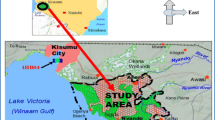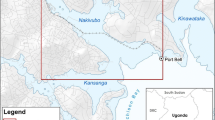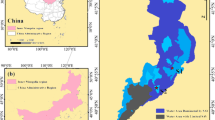Abstract
Wetlands support livelihoods of millions of people in develo** countries. However, wetland land cover change, as a result of growing population and subsequent anthropogenic activities, has been evident at a global scale, and ongoing micro-climate alteration has further deteriorating its ecological condition. Nepal is equally vulnerable to wetland changes that can have direct effects on the sustenance of local wetland-dependent people. This study thus attempts to look at how wetland areas of Nepal are undergoing changes, taking a case of Ghodaghodi Lake Complex (GLC). Remote sensing technique, climate, and population data were used in the analysis aided by focus group discussions and key informant interviews. Results showed that total population of the study area has been increased drastically in recent decades. Landsat image analysis for 25 years (1989–2016) depicts changes in the GLC in its land cover, with maximum expansion observed in settlement followed by river and banks, whereas maximum reduction was observed in forests, followed by areas of agricultural land and lake. Similarly, diurnal temperature is increasing while total annual rainfall is slightly decreasing during the same period. Locals have perceived ecological degradation in the GLC due to both anthropogenic pressure and climatic variability. The study outlines linkage of drivers for GLC degradation and finally makes recommendations to achieve longer term sustainability of the lake complex.







Similar content being viewed by others

Notes
Following the new constitution, in 2015, all old administrative divisions (eg.municipalities and VDCs) were restructured into new 7 provinces, and 753 municipalities and rural municipalities. At present, the GLC lies in Ghodaghodi Municipality.
References
Alkama, R., & Cescatti, A. (2016). Biophysical climate impacts of recent changes in global forest cover. Science, 351(6273), 600–604.
Aryal, R. R., Shrestha, H. L., & Khanal, S. (2011). Using Landsat data for assessing forest cover change and fragmentation in Laljhadi corridor of Kanchanpur district, Nepal. Banko Jankari, 21(2), 40–44.
Badar, B., Romshoo, S. A., & Khan, M. A. (2013). Modelling catchment hydrological responses in a Himalayan lake as a function of changing land use and land cover. Journal of Earth System Science, 122(2), 433–449.
Bajracharya, S. R., & Mool, P. (2009). Glaciers, glacial lakes and glacial lake outburst floods in the Mount Everest region, Nepal. Annals of Glaciology, 50(53), 81–86.
Bamford, A. J., Razafindrajao, F., Young, R. P., & Hilton, G. M. (2017). Profound and pervasive degradation of Madagascar’s freshwater wetlands and links with biodiversity. PLoS ONE, 12(8), e0182673.
Behera, M. D., Chitale, V. S., Shaw, A., Roy, P. S., & Murthy, M. S. R. (2012). Wetland monitoring, serving as an index of land use change: a study in Samaspur Wetlands, Uttar Pradesh, India. Journal of the Indian Society of Remote Sensing, 40(2), 287–297.
Briga, M., & Verhulst, S. (2015). Large diurnal temperature range increases bird sensitivity to climate change. Scientific Reports, 5, 16600. https://doi.org/10.1038/srep16600.
CBS. (1991). National population and housing census 1991 report. Kathmandu, Nepal: Central Bureau of Statistics, National Planning Commission Secretariat, Government of Nepal.
CBS. (2001). National population and housing census 2001 report. Kathmandu, Nepal: Central Bureau of Statistics, National Planning Commission Secretariat, Government of Nepal.
CBS. (2011). National population and housing census 2011 report. Kathmandu, Nepal: Central Bureau of Statistics, National Planning Commission Secretariat, Government of Nepal.
Chaudhary, S., Chettri, N., Uddin, K., Khatri, T. B., Dhakal, M., Bajracharya, B., & Ning, W. (2016). Implications of land cover change on ecosystem services and people’s dependency: a case study from the Koshi Tappu wildlife reserve, Nepal. Ecological Complexity, 28, 200–211.
Chettri, N., Uddin, K., Chaudhary, S., & Sharma, E. (2013). Linking spatio-temporal land cover change to biodiversity conservation in the Koshi Tappu Wildlife Reserve, Nepal. Diversity, 5, 335–351.
Clair, T. A. (1998). Canadian freshwater wetlands and climate change. Climatic Change, 40, 163–165.
Congalton, R. G. (1991). A review of assessing the accuracy of classifications of remotely sensed data. Remote Sensing of the Environment, 37(1), 35–46.
Congalton, R. G., & Green, K. (2008). Assessing the accuracy of remotely sensed data: principles and practices. New York, NY, USA: CRC Press.
Dahal, N., Shrestha, U. B., Tuitui, A., & Ojha, H. R. (2019). Temporal changes in precipitation and temperature and their implications on the streamflow of Roshi River, central Nepal. Climate, 7(1), 3. https://doi.org/10.3390/cli7010003.
Davidson, N. C. (2014). How much wetland has the world lost? Long term and recent trends in global wetland area. Marine and Freshwater Research, 65, 934–941.
Debnath, J., Das, N., Ahmed, I., & Bhowmik, M. (2017). Channel migration and its impact on land use/land cover using RS and GIS: a study on Khowai River of Tripura, North East India. The Egyptian Journal of Remote Sensing and Space Sciences, 20, 197–210. https://doi.org/10.1016/j.ejrs.2017.01.009.
DoF. (2017). Wetlands of western Nepal: a brief profile of selected lakes (p. 281). Kathamndu, Nepal: Department of Forest, Babarmahal.
DoFD. (2012). Country profile – Nepal 2011/2012, fisheries sub-sector. Kathmandu, Nepal: Directorate of Fisheries Development, Kathmandu.
Englehart, P. J., & Douglas, A. V. (2005). Changing behavior in the diurnal range of surface air temperatures over Mexico. Geophysical Research Letters, 32, L01701.
Erwin, K. L. (2009). Wetlands and global climate change: the role of wetland restoration in a changing climate. Wetland Ecology and Management, 17, 71–84.
Fei, L., Shuwen, Z., Kun, B., Jiuchun, Y., Qing, W., & Li**, C. (2015). The relationships between land use change and demographic dynamics in western Jilin province. Journal of Geographical Science, 25(5), 617–636.
Funkenberg, T., Binh, T. T., Moder, F., & Dech, S. (2014). The Ha Tien Plain: wetland monitoring using remote sensing. International Journal of Remote Sensing, 35(8), 2893–2909.
Gallant, A. L. (2015). The challenges of remote monitoring of wetlands. Remote Sensing, 7, 10938–10950.
Gao, J. (1998). A hybrid method towards accurate map** of mangroves in a marginal habitat from SPOT multispectral data. International Journal of Remote Sensing, 19(10), 1887–1899.
Gardner, R. C., Barchiesi, S., Beltrame, C., Finlayson, C. M., Galewski, T., Harrison, I., Paganini, M., Perennou, C., Pritchard, D. E., Rosenqvist, A., & Walpole, M. (2015). State of the world’s wetlands and their services to people: a compilation of recent analyses. Gland, Switzerland: Ramsar Briefing Note no. 7, Ramsar Convention Secretariat.
Ghobadi, Y., Pradhan, B., Shafri, H. Z. M., Ahmad, N. B., & Kabiri, K. (2015). Spatio-temporal remotely sensed data for analysis of the shrinkage and shifting in the Al Hawizeh wetland. Environmental Monitoring and Assessment, 187, 41–56.
Gong, P., Niu, Z., **ao, C., et al. (2010). China’s wetland change (1990-2000) determined by remote sensing. Science China Earth Sciences, 53(7), 1036–1042.
Green, E. P., Clark, C. D., Mumby, P. J., Edwards, A. J., & Ellis, A. (1998). Remote sensing techniques for mangrove map**. International Journal of Remote Sensing, 19(5), 935–956.
Hartter, J., & Southworth, J. (2009). Dwindling resources and fragmentation of landscapes around parks: wetlands and forest patches around Kibale National Park, Uganda. Landscape Ecology, 24, 643–656.
Hatfield, J. L., & Prueger, J. H. (2015). Temperature extremes: effect on plant growth and development. Weather and Climate Extreme, 10, 4–10.
Hazarika, N., Das, A. K., & Borah, S. B. (2015). Assessing land-use changes driven by river dynamics in chronically flood affected Upper Brahmaputra plains, India, using GIS-RS techniques. The Egyptian Journal of Remote Sensing and Space Science, 18(1), 107–118.
Hu, S., Niu, Z., Chen, Y., Li, L., & Zhang, H. (2017). Global wetlands: potential distribution, wetland loss, and status. Science of the Total Environment, 586, 319–327. https://doi.org/10.1016/j.scitotenv.2017.02.001.
IUCN. (1998). An inventory of Nepal’s Tarai Wetlands. Kathmandu: IUCN Nepal.
Junk, W. J., An, S., Finlayson, C. M., Gopal, B., Kvet, J., Mitchell, S. A., Mitsch, W. J., & Robarts, R. D. (2013). Current state of knowledge regarding the world’s wetlands and their future under global climate change: a synthesis. Aquatic Sciences, 75, 151–167.
Kafle, G. (2005). Avifaunal survey and vegetation analysis focusing on threatened and near-threatened species on Ghodaghodi Lake of Nepal. Bedford: A Report Submitted to Oriental Bird Club (OBC).
Kafle, G., & Savillo, I. T. (2009). Present status of Ramsar sites in Nepal. International Journal of Biodiversity and Conservation, 1(5), 146–150.
Karki, R., Hassan, S. U., Schickhoff, U., Scholten, T., & Bohner, J. (2017). Rising precipitation extremes across Nepal. Climate, 5(1). https://doi.org/10.3390/cli5010004.
Karki, S., Thandar, A. M., Uddin, K., Tun, S., Aye, W. M., Aryal, K., Kandel, P., & Chettri, N. (2018). Impact of land use land cover change on ecosystem services: a comparative analysis on observed data and people perception in Inle Lake, Myanmar. Environmental System Research, 7, 25. https://doi.org/10.1186/s40068-018-0128-7.
Karl, B., Karoly, D. J., & Arblaster, J. M. (2004). Diurnal temperature range as an index of global climate change during the twentieth century. Geophysical Research Letters, 31, L13217.
Kayranli, B., Scholz, M., Mustafa, A., & Hedmark, A. (2010). Carbon storage and fluxes within freshwater wetlands: a critical review. Wetlands, 30, 111–124.
Khanal, S. (2009). Change assessment of forest cover in Ghodaghodi Lake area in Kailali district of Nepal. Banko Jankari, 19(2), 15–19.
Lamsal, P., Pant, K. P., Kumar, L., & Atreya, K. (2014). Diversity, uses, and threats in the Ghodaghodi Lake Complex, a Ramsar site in western lowland Nepal. ISRN Biodiversity, 680102, 12.
Lamsal, P., Atreya, K., Pant, K. P., & Kumar, L. (2015a). An analysis of willingness to pay for community based conservation activities at the Ghodaghodi Lake Complex, Nepal. International Journal of Biodiversity Science, Ecosystem Services & Management, 11, 341–348.
Lamsal, P., Pant, K. P., Kumar, L., & Atreya, K. (2015b). Sustainable livelihood through conservation of wetland resources: a case of economic benefits from Ghodaghodi Lake, western Nepal. Ecology and Society, 20(1), 10.
Lamsal, P., Atreya, K., Pant, K. P., & Kumar, L. (2016). Tourism and wetland conservation: application of travel cost and willingness to pay an entry fee at Ghodaghodi Lake Complex, Nepal. Natural Resources Forum, 40, 51–61.
Lamsal P., Atreya K., Pant K.P., & Kumar L. (2017) People’s Dependency on Wetlands: South Asia Perspective with Emphasis on Nepal. In: Prusty B., Chandra R., Azeez P. (eds) Wetland Science. Springer, New Delhi
Lopez-Maldonado, Y., & Berkes, F. (2017). Restoring the environment, revitalizing the culture: cenote conservation in Yucatan, Mexico. Ecology and Society, 22(4), 7.
Mabwoga, S. O., & Thukral, A. K. (2014). Characterization of change in the Harike wetland, a Ramsar site in India, using Landsat satellite data. SpringerPlus, 3, 576. https://doi.org/10.1186/2193-1801-3-576.
Mitsch, W. J., Bernal, B., Nahlik, A. M., Mander, U., Zhang, L., Anderson, C. J., Jorgensen, S. E., & Brix, H. (2013). Wetlands, carbon, and climate change. Landscape Ecology, 28, 583–597.
MoFE. (2018). National Ramsar Strategy and Action Plan, Nepal (2018-2024). Ministry of Forests and Environment. Kathmandu, Nepal: Singha Durbar.
MoPE. (2017). National Population Repot. Ministry of Population and Environment (p. 274). Kathmandu: Singha Durbar.
Munyati, C. (2000). Wetland change detection on the Kafue Flats, Zambia, by classification of a multitemporal remote sensing image dataset. International Journal of Remote Sensing, 21(9), 1787–1806.
Ozesmi, S. L., & Bauer, M. E. (2002). Satellite remote sensing of wetlands. Wetland Ecology and Management, 10, 381–402.
Papastergiadou, E., Kagalou, I., Stefanidis, K., Retalis, A., & Leonardos, I. (2010). Effects of anthropogenic influence on the trophic state, land uses and aquatic vegetation in a shallow Mediterranean lake: implication for restoration. Water Resources Management, 24, 415–435.
Perugini, L., Caporaso, L., Marconi, S., Cescatti, A., Quesada, B., de Noblet-Ducoudre, N., House, J. I., & Arneth, A. (2017). Biophysical effects on temperature and precipitation due to land cover change. Environmental Research Letters, 12, 053002.
Prashar, P. & Shah, S. (2016). Impact of fertilizers and pesticides on soil microflora in agriculture. In: E. Lichtfouse (ed.), Sustainable agriculture reviews, Vol 19, Springer, Cham. 331-361, https://doi.org/10.1007/978-3-319-26777-7_8
Prigent, C., Papa, F., Aires, F., Jimenez, C., Rossow, W. B., & Matthews, E. (2012). Changes in land surfaces water dynamics since the 1990s and relation to population pressure. Geophysical Research Letters, 39, L08403.
Rahel, F. J., & Olden, J. D. (2008). Assessing the effects of climate change on aquatic invasive species. Conservation Biology, 22(3), 521–533.
Rashford, B. S., Adams, R. M., Wu, J., Voldseth, R. A., Guntenspergen, G. R., Werner, B., & Johnson, W. C. (2014). Impacts of climate change on land use and wetland productivity in the Prairie Pothole Region of North America. Regional Environmental Change, 16, 515–526.
Reis, V., Hermoso, V., Hamilton, S. K., Ward, D., Fluet-Chouinard, E., Lehner, B., & Linke, S. (2017). A global assessment of inland wetland conservation status. BioScience, 67(6), 523–533.
Rimal, B., Baral, H., Stork, N. E., Paudyal, K., & Rijal, S. (2015). Growing city and rapid land use transition: assessing multiple hazards and risks in the Pokhara Valley, Nepal. Land, 4, 957–978.
Romshoo, S. A., & Rashid, I. (2014). Assessing the impacts of changing land cover and climate on Hokersar wetland in Indian Himalayas. Arabian Journal of Geosciences, 7(1), 143–160.
Ruan, R., Zhang, Y., & Zhou, Y. (2008). Change detection of wetland in Hongze Lake using a time series of remotely sensed imagery. The international archives of the photogrammetry, remote sensing and spatial information sciences, Vol. XXXVII, Part B7. Bei**g: 1545–1548.
Sah, J. P., & Heinen, J. T. (2001). Wetland resource use and conservation attitudes among indigenous and migrant peoples in Ghodaghodi Lake area, Nepal. Environmental Conservation, 28(4), 345–356.
Shrestha, R. K. (2010). Fertilizer policy development in Nepal. The Journal of Agriculture and Environment, 11, 126–137.
Shrestha, A. B., & Joshi, S. P. (2009). Snow cover and glacier change study in Nepalese Himalaya using remote sensing and geographic information system. Journal of Hydrology and Meteorology, 6(1), 26–36.
Shrestha, A. B., Bajracharya, S. R., Sharma, A. R., Duo, C., & Kulkarni, A. (2016). Observed trends and changes in daily temperature and precipitation extremes over the Koshi river basin 1975-2010. International Journal of Climatology, 37(2), 1066–1083.
Sinha, C. P. (2011). Climate change and its impacts on the wetlands of North Bihar, India. Lakes & Reservoirs: Research and Management, 16, 109–111.
Sinha, P., Kumar, L., Drielsma, M., & Barrett, T. (2014). Time-series effective habitat area (EHA) modeling using cost-benefit raster based technique. Ecological Informatics, 19, 16–25.
Song, C., Woodcock, C. E., Seto, K. C., Lenny, M. P., & Macomber, S. A. (2001). Classification and change detection using Landsat TM data: when and how to correct atmospheric effects? Remote Sensing of Environment, 75(2), 230–244.
Sun, C., Zhen, L., & Miah, G. (2017). Comparison of ecosystem services provided by China’s Poyang Lake wetland and Bangladesh’s Tanguar Haor wetland. Ecosystem Services, 26, 411–421.
Thapa, R. B., & Murayama, Y. (2009). Examining spatiotemporal urbanization patterns in Kathmandu Valley, Nepal: remote sensing and spatial metrics approaches. Remote Sensing, 1(3), 534–556.
Thapa, L. B., Thapa, H., & Magar, B. G. (2015). Perceptions, trends and impacts of climate change in Kailali district, far west Nepal. International Journal of Environment, 4(4), 62–76.
van Asselen, S., Verburg, P. H., Vermaat, J. E., & Janse, J. H. (2013). Drivers of wetland conversion: a global meta-analysis. PLoS ONE, 8(11), e81292.
Wali, A., Alvira, D., Tallman, P. S., Ravikumar, A., & Macedo, M. O. (2017). A new approach to conservation: using community empowerment for sustainable well-being. Ecology and Society, 22(4), 6.
Werner, B. A., Johnson, W. C., & Guntenspergen, G. R. (2013). Evidence for 20th century climate warming and wetland drying in the North American Prairie Pothole Region. Ecology and Evolution, 3(10), 3471–3482.
Whitehead, P. G., Wilby, R. L., Battarbee, R. W., Kernan, M., & Wade, A. J. (2009). A review of the potential impacts of climate change on surface water quality. Hydrological Sciences Journal, 54(1), 101–123.
Woodward, G., Perkin, D. M., & Brown, L. E. (2010). Climate change and freshwater ecosystems: impacts across multiple level of organizations. Philosophical Transactions of the Royal Society B, 365, 2093–2106.
Wu, G., Gao, Y., Wang, Y., Wang, Y., & Xu, D. (2015). Landuse/landcover changes and their driving forces around wetlands in Shangri-La County, Yunnan Province, China. International Journal Sustainable Development and World Ecology, 22(2), 110–116.
**e, Z., Liu, J., Ma, Z., Duan, X., & Cui, Y. (2012). Effect of surrounding land use change on the wetland landscape pattern of a natural protected area in Tian**, China. International Journal of Sustainable Development and World Ecology, 19(1), 16–24.
Zacharia, M., Elias, A., Jeremiah, K., Simon, M., & Olang, L. O. (2013). Assessment of land cover changes in Lake Olbolosat Region of the Central Kenyan Highlands using Landsat satellite imagery aided by indigenous knowledge. Journal of Biodiversity Management & Forestry, 2, 2.
Zhao, Z., Zhang, Y., Liu, L., Liu, F., & Zhang, H. (2015). Recent changes in wetlands on the Tibetan Plateau: a review. Journal Geographical Sciences, 25(7), 879–896.
Zhu, J., Sun, G., Li, W., Zhang, Y., Miao, G., Noormets, A., McNulty, S. G., King, J. S., Kumar, M., & Wang, X. (2017). Modeling the potential impacts of climate change on the water table level of selected forested wetlands in the southeastern United States. Hydrology and Earth System Science, 21, 6289–6305.
Author information
Authors and Affiliations
Corresponding author
Additional information
Publisher’s note
Springer Nature remains neutral with regard to jurisdictional claims in published maps and institutional affiliations.
Rights and permissions
About this article
Cite this article
Lamsal, P., Atreya, K., Ghosh, M.K. et al. Effects of population, land cover change, and climatic variability on wetland resource degradation in a Ramsar listed Ghodaghodi Lake Complex, Nepal. Environ Monit Assess 191, 415 (2019). https://doi.org/10.1007/s10661-019-7514-0
Received:
Accepted:
Published:
DOI: https://doi.org/10.1007/s10661-019-7514-0



